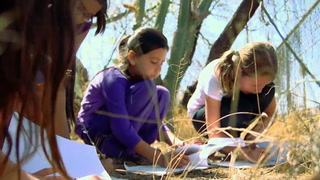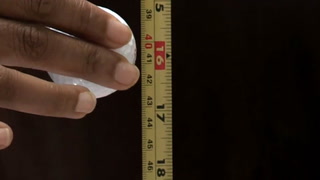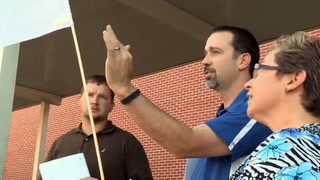NGSS: Science & Engineering Practices Transcript
Speaker 1: For energy in the bounce, and that’s really the kinetic energy. As teachers if we really find ways to get kids actively engaged -
Speaker 2: Why? What’s happening?
Speaker 1: - They’re going to share what they have learned about science. They’re going to be curious about things they see on television and that they read in the news. Hopefully then we’ll have more people that really enjoy science and understand science.
Speaker 2: As you engage in your science performance, I will want you to be thinking about what you’re doing. Specifically, we’ll be talking a lot about the practices.
The next generation science standards include three dimensions: science and engineering practices, the disciplinary core ideas and the cross-cutting concepts.
Speaker 2: I’d like you to think about that intersection of the three dimensions, and where it’s coming together in the classroom. For those of you that are familiar with the practices, there are eight.
Today we engage teachers in practices found within the framework for K-12 science education. They’re designed for students. They’re what we want students to be doing. The science performance that the participants engaged in today was specifically, analyzing and interpreting data. We want to look at the scientific process, and that this is what scientists go through in the real world.
Speaker 1: As teachers it’s important for us to scaffold those experiences, especially early on, to make sure that they understand how to organize their data, and look for patterns and evidence. I think as they engage in these practices more often, I think they’re really going to own those practices along with the content.
All we’re changing is the height.
Speaker 1: It’s important that kids are constructing explanations, that they are constructing arguments.
Started at seven.
Speaker 1: They’re using evidence, and they’re communicating their findings.
Speaker 2: In groups of three, you will investigate the height that a golf ball bounces off of a hard surface. You’ll choose four different drop heights. After you drop it, where it returns at its peak, is going to be its bounce height.
Speaker 3: That one’s a 16.
Speaker 2: Make sure you analyze your data with your groups, and then once you've identified the patterns, you’re not done. You need to talk about what’s causing those patterns to occur. What’s the science behind this? What’s happening?
Speaker 1: More gravitational potential energy. All we’re changing is the height.
So we looked at that data to continue to look for that linear relationship. So that’s a pretty traditional activity that you might do in terms of looking at the bounce height, but by really looking at the data closely, and having to look for those relationships, it really increased the depth of that particular investigation.
Speaker 2: So the lower you dropped it, the lower it bounced?
Speaker 1: The closer it got back to its original.
Speaker 2: So what does that tell you?
Speaker 1: Nicole came by and we showed her our graph and our percentage difference and she said, “Well, so why does that happen? What’s going on?” And that added really another layer of depth, because we started taking about gravitational potential energy, kinetic energy, and then we shared out, and really probed that in more depth.
The more kinetic energy we have, like a ratio.
It really made us think more deeply about gravity, energy, friction and the system that was involved. So it was more than averaging data, calculating data, writing a conclusion. It really became more about, why and what type of evidence do we have to really construct an explanation?
Speaker 2: Any other patterns?
Speaker 4: The higher the drop height, the larger difference between drop height and bounce height.
Speaker 2: What’s causing that pattern to occur?
Speaker 4: Because gravity doesn't change. The system’s constant.
Speaker 2: Is there even a more simple pattern than that? Yeah.
Speaker 5 : It always bounces less than it was dropped from.
Speaker 2: Why? What’s causing that to happen?
Speaker 1: So all of those different ideas that are in the science and engineering practices, really get kids actively engaged, so they’re really thinking. It’s not confirming, but looking for more information. That focus on evidence-based explanations is really key, and I think is essential in those practices.
Speaker 2: What’s different when you’re having to analyze to come up with that?
Speaker 6: You’re going to remember it more, because you’re doing it.
Speaker 2: You’re doing it. They’re involved in doing it. That thinking process that goes on behind it is so much more critical than just receiving that information.
Speaker 1: I’m really most excited about bringing home those ideas of thinking about labs that I already do, that really could be so much better, if I really am more mindful of the science and engineering practices.
Speaker 2: This particular performance really did emphasize analyzing data. A lot of you were starting to ask questions, which is exactly what we want to have happen. It’s again, an interrelated part of those practices coming out. You’re using other practices at the same time.
Speaker 1: So now you’re going to start at 40 centimeters.
We started out gathering information but once we started analyzing our data, we realized we needed more data, so we went back and gathered more data. It was really a fluid process. The more we learned, the more that we did, the more questions that we had.
Speaker 3: That works. 78.
Speaker 2: Or are you losing that each time it bounces?
Speaker 2: Some of the excitement that I've seen with teachers is that they realize that this is really how learning occurs. Teachers that are teaching both science and mathematics can see how these practices really do interconnect.
Speaker 1: We had 84. So we were close. That’s not bad.












51 Comments
Brandy Roberts Feb 9, 2023 8:47am
Such a good vidoe on how to teach science.
Karol Wagar Feb 8, 2023 10:01am
I really love the way the students were so creative. Great film clip.
LINDA REIF Feb 7, 2023 2:58pm
Loved the creativity the students were given the opportunity to use with science.
SHERI NEUBAUER Jan 31, 2023 8:48pm
Students are creative! We need to encourage them.
Amy Baroni Jan 30, 2023 6:28pm
I enjoyed the video. Teaching science this way is so much more meaningful.